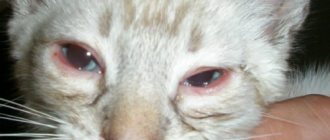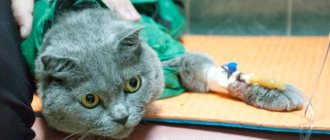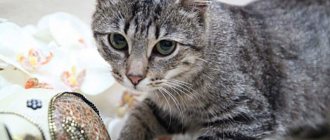13370Pavel
3
Ten days after birth, the kittens’ eyes begin to open, initially narrow slits appear, and then two small buttons glow like beads. This is a normal process. But what to do when the kitten’s eyes do not open? This phenomenon causes concern among owners.
Watching the little beads open is just a pleasure. To begin with, tears appear in the inner corner, then a small crack forms, which increases every day. As a result, small shiny buttons appear. But if your eyes are difficult to open, is it worth doing anything?
Why does a cat not open one eye?
Cats' eyes are often damaged and injured in everyday life.
An animal can get injured on the street, in contact with relatives, or as a result of intense games with large objects. This is especially true for kittens, who, in the impulse of their activity, quite often injure themselves. Often, owners notice that the cat’s eye does not open and begin to sound the alarm. This phenomenon does not always require drug treatment, but in some cases the animal should be shown to a veterinarian as soon as possible in order to avoid dangerous complications.
Eye injuries
Most often, a cat does not open one eye when a grain of sand, speck or any other foreign body enters it. Movement of the eyelids and eyeball causes pain, so the animal prefers to keep the eye closed. A characteristic symptom of this phenomenon is profuse lacrimation from a closed eye. Over time, tears will wash away the debris from the eye, and the cat will no longer keep it closed. This usually happens after a few hours.
Another likely reason that a cat’s eyes won’t open is an injury while washing itself. If an animal vigorously rubs its muzzle with its paws, it may accidentally damage the mucous membrane of the eye, or get hair under the eyelid. This causes discomfort, so the cat keeps the eye closed until the mucous membrane is restored or tears wash out the hair.
Cats often come into conflict with their relatives. If a cat comes back from a walk dirty, wounded and does not open one eye, it means he has experienced a serious fight with a competitor for his territory. In this case, it is recommended to observe the behavior of the animal. If the cat feels well, despite the injuries, demonstrates a normal appetite and normal behavior, there is no cause for concern. After a short time, the mucous membrane will recover and the cat will open its eye again.
The alarm should be sounded if wounds are visible around the eye, and blood, mucus or pus oozes from under the closed eyelid. If you notice such symptoms, your cat should be taken to the veterinarian as soon as possible to avoid loss of vision. Sometimes conflicts with relatives lead to severe injuries, and bleeding from a closed eye may indicate severe damage.
If the cat's right eye does not open, it is recommended to wait several hours. In most cases, a cat will keep its eyelids closed due to a common household injury. If there is no foreign discharge, and only slight lacrimation is observed, there is no reason to panic. If a cat keeps its eye closed for more than a day, you should show the animal to a veterinarian. It may be necessary to remove the foreign body. To prevent infection of the damaged eye, the doctor will prescribe antibacterial drops, solution or special gel.
Inflammation of the third eyelid
The nictitating membrane in an active cat is invisible. The transparent membrane protects the eye sphere from dust particles and debris. Due to the inflammatory process, the membrane hypertrophies and no longer fits under the eyelids.
Most often, unilateral inflammation is observed due to the following reasons:
- infectious diseases;
- allergic reactions;
- injuries;
- internal non-communicable diseases;
- congenital predisposition.
Most often, Persians, Britons, as well as mixed breeds and cats of related breeds get sick. Treatment is surgery. To prevent inflammation of the eyelid, you should purchase a pet from trusted breeders and not engage in spontaneous selection.
Be sure to read:
What to do if a cat has a lump on its ear?
Conjunctivitis in cats
Another reason why a cat’s left eye does not open is conjunctivitis. The disease develops due to the entry of dirt, fungal spores, parasites or pathogenic microorganisms under the eyelid. Usually, with conjunctivitis, the eyes become red and very watery, but with severe purulent inflammation they can turn sour. This makes the affected eye difficult to open, so the cat keeps it closed.
With severe inflammation, edema may develop. Then the closed eye increases in size, which is visible to the naked eye. When you try to unstick the cat's eyelids, the animal feels pain and breaks away. In this case, you need to visit a veterinarian. The doctor will prescribe drops and solutions to treat the affected eye. Antibiotic products are usually used. With timely treatment, conjunctivitis goes away within a few days.
Treatment at home
When infectious eye diseases are detected in cats, they are prescribed instillation and rinsing with aqueous solutions of antibiotics:
- Sofradex;
- Sulfacyl sodium;
- Kanamycin;
- Levomycetin.
In this case, not only the affected eye is treated, but also the second one, even if it looks healthy. Apply an antibiotic ointment (for example, tetracycline) 2-3 times a day and wipe the eyelids with Furacilin solution. In case of severe swelling of the eyelids and severe pain, a solution of hormones (hydrocortisone and novocaine) is injected into the animal’s eyeball. Such procedures are carried out in a hospital.
If a foreign body gets into the pet's eye, the veterinarian removes it with a cotton swab, injection needle or tweezers, and then injects an anesthetic into the eyeball.
Excessive lacrimation caused by an allergen is treated with antihistamines and hormonal ointments.
As additional remedies to basic medications, some cat owners use tinctures and decoctions of beneficial herbs. For example, sage, chamomile, St. John's wort, calendula. They wash your pet's eyes twice a day. The procedures help get rid of pus, stop inflammation, and heal affected mucous membranes. Instead of herbal recipes, it is allowed to use strong brewed black tea or a weak solution of manganese.
Kitten eye problems
Often, owners of small kittens are faced with the problem of sour eyes, especially if the animal was taken from the street. Discharge does not necessarily indicate conjunctivitis or other pathology. Often souring occurs due to the fact that the kitten simply does not know how to maintain personal hygiene. In this case, it is recommended to use special products designed to care for the eyes of cat babies. You need to wipe your eyes with this solution several times a day, and after a few days the problem will be completely solved.
Conjunctivitis in small kittens taken from the street can be a result of dust exposure, and also often develops against the background of infection with parasites. In this case, you can get rid of the problem of souring and inflammation of the mucous membrane only through complex treatment.
In rare cases, an animal's eye does not open due to abnormalities in the structure of the eyelid or injuries received in childhood. This may be due to a fall, impact or other reasons. Kittens face this problem, but not adult animals. For congenital eyelid anomalies, drug treatment is ineffective, but the doctor can perform surgery.
Description of the most likely causes
If a cat does not open one eye, then there is a high probability that the cause is related to injury. Two organs of vision are most often affected by viral infections. In older individuals, a problem with one eye may be associated with a tumor process, due to which the organ may increase in size and alarming symptoms appear in the form of bloody discharge or a foul odor. To make a diagnosis, an external examination of the animal must be carried out; if necessary, ophthalmoscopy is prescribed, with the help of which the following possible pathologies are excluded or confirmed:
- Blepharitis. An inflammatory process affecting mainly the edges of the eyelid. Leads to redness and swelling of the outer side of the eyelid. In most cases, it is accompanied by severe itching, due to which the pet can inflict even greater injuries on itself with its claws. If a cat’s eyes cannot open and redness of the eyelid is visible, then it is necessary to rule out blepharitis, which can be caused by a number of reasons. Most often, the inflammatory process is triggered by injuries (scratches from claws or tree branches) and congenital pathologies (entropion of the eyelid, double row of eyelashes). Sometimes an external examination by an ophthalmologist is sufficient to determine the extent of damage to the eyelid, conjunctiva or cornea. For minor damage caused by scratches, antibacterial drops (iris, tsiprovet) and ointments placed under the eyelid (korneregel, tetracycline) are prescribed. In difficult cases, the animal is put on a special medical cap to prevent the possibility of scratching.
- Injury. If a cat’s eyes do not open after playing or fighting with other animals, then it is necessary to conduct an external examination of the organ to identify scratches on the cornea, eyelid or conjunctiva. Even the slightest microtrauma to the cornea can cause significant discomfort to the pet when blinking. There is also a risk of developing an inflammatory process due to bacterial infection entering an open wound. Minor injuries heal quickly (for this, Tobrex and Kornegel drops are used in the form of an ointment, which is placed under the eyelid). But for deep corneal ulcers, systemic antibiotics are used until complete healing (this can take from 2 to 4 weeks, provided that there are no complications in the form of keratitis or uveitis).
- Turn of the century. It is considered a congenital pathology that can manifest itself at any period of life. The process can be triggered by eyelid trauma and viral infections. This problem most often occurs in Maine Coons, Persian and British cats. At first, the animal’s eye does not fully open; later, the eyelid may touch the cornea with every blink, which will lead to injury. The development of keratitis can lead to the conjunctiva becoming covered with a cloudy film. If the necessary assistance is not provided in time, the pet’s vision may decrease, and in some cases there is a risk of going blind in the damaged eye. The problem of entropion of the eyelids can only be solved surgically. The operation is performed under anesthesia. Excess eyelid flaps are trimmed and the wound is sutured. Healing takes 3-7 days.
- Incorrect eyelash growth. There are cases when an animal may experience abnormal growth of one or several eyelashes at once. Almost always, this process leads to injury to the cornea, as the eyelash grows inward and irritates the conjunctiva with every blink. At the initial stage, this may manifest itself in increased lacrimation, redness of the mucous membrane of the eyelid and conjunctiva. If the cat’s eyes do not open, then the situation could be complicated by keratitis and uveitis. Typically, these pathologies are accompanied by severe itching, due to which claw wounds may be present in the area of the pet's face. The problem can be resolved only by removing incorrectly growing eyelashes. This is done in a hospital setting, with an individual approach to pain relief or anesthesia in each case. In some cases, it is possible to carry out the procedure without using both.
- Foreign body. Animals can also get any debris into their eyes, which does not always come out with tears. This is especially true for splinters that can dig into the mucous membrane of the eyelid or conjunctiva. These can be plant seeds or needles from cacti. It is important to notice the problem in time and eliminate the irritating factor. In some cases, you can do this yourself using tweezers; sometimes you have to seek help from a veterinarian, who has a wider selection of gripping tools in his arsenal.
You need to understand that if a cat’s eyes do not fully open or they constantly squint, then it is necessary to look for and eliminate the irritating factor, since there is a risk of developing an inflammatory process with all the ensuing complications.
Causes of the disease
A disease in which a cat's eyes are half covered with a film is not so rare. The filmy layer on the surface of a cat's eyelids (on the inside) in most cases is white. Sometimes it covers a significant part of the animal's eye. It doesn’t look pretty, and the pet’s well-being worsens. Therefore he should be helped. To overcome a disease in which your pet's eyes are half covered with a film, you need to know the causes of the pathological condition.
The third eyelid (this is the name given to the film that covers a cat’s eyes) is the conjunctiva. It covers the surface of the eyelids (lower and upper), as well as the eyeball. In cats, in the inner corners of the eyes there is a fold of the conjunctiva (nictitating membrane). It ensures the full functioning of the visual organ.
It is impossible to see the fold with fully open eyes (if they are healthy). It becomes noticeable only when the animal squints its eyes or blinks. The nictitating membrane contributes to :
- proper distribution of tear fluid;
- removal of foreign elements from the surface of the visual organ (for example, dust, grains of sand);
- producing up to 1/3 of tear fluid.
If a cat’s fully open eyes suddenly become half covered with a film, this indicates the development of negative processes in the animal’s body. There are many topics on veterinary forums about the appearance of a film on a cat’s eyes. This pathology is associated with prolapse of the 3rd eyelid. It occurs due to swelling of the nictitating membrane, the functions of which are impaired. The animal's eyes do not receive the required amount of moisture, so they become more vulnerable to negative factors.
The opposite situation may also arise when the visual organ of a pet suffers from excess moisture. There are many reasons why a cat's third eyelid may fall out. In fact, this pathology is not the main disease. This is more likely a sign of another disease. For example :
- conjunctivitis;
- infections caused by bacteria;
- diseases of internal organs (most often associated with disruption of the digestive tract);
- parasites in the animal's body;
- mechanical eye damage;
- foreign objects getting into the cat’s eyes, causing injury, inflammation and swelling;
- cataracts, blockage of the eye vessels, strabismus (the presence of such problems is indicated by the blue color of the film on the eyes).
If you notice that a film has begun to appear on your pet cat's eyes, take the animal to the veterinarian as soon as possible. Timely diagnosis and proper treatment will help avoid re-infection and quickly restore the health of your furry pet. Using an ophthalmoscope, a specialist will quickly find out the cause of eye inflammation and offer a high-quality and effective course of treatment. If it turns out that the film on the cat’s eyes is due to cataracts or blockage of the vessels of the visual organ, surgical intervention is performed.
We recommend reading: Calcivirosis Prevention and Treatment
Kitten can't open his eyes
12904Pavel 1
Ten days after birth, the kittens’ eyes begin to open, initially narrow slits appear, and then two small buttons glow like beads. This is a normal process. But what to do when the kitten’s eyes do not open? This phenomenon causes concern among owners.
Watching the little beads open is just a pleasure. To begin with, tears appear in the inner corner, then a small crack forms, which increases every day. As a result, small shiny buttons appear. But if your eyes are difficult to open, is it worth doing anything?
About the vision of cats
To clarify the problem and correctly assess the current circumstances, the owner must know about the structure of the kitten’s eye. In relation to the human organs of vision, the eye size of pets is much larger. The retinal area also contains nerve endings or rods. There are almost 7 times more rods than cones, which indicates that furry friends have much better vision than humans, so they see well in the dark.
The round shape of the eyeball with the lens located at the center helps to expand the viewing angle. The eyes are protected from the effects of external factors, that is, foreign bodies entering the eyelids and mucous membranes. Moreover, cats have three eyelids, and this only enhances their protection.
Research has found that cats see the world in color, and not in black and white, as many people think. It’s not for nothing that the kitten likes to sit next to the screen when watching TV.
Contagious diseases
Damage to one eye is typical for the following infectious diseases:
- herpes;
- chlamydia;
- demodicosis;
Herpes
Blepharospasm
A viral disease better known as rhinotracheitis. An acute course is typical for unvaccinated kittens from two to three months. Chronic disease occurs in adult animals during periods of weakened immunity. At the initial stage, blepharitis develops, which is characterized by inflammation of the eyelids. They stick together and blepharospasm develops.
Subsequently, the second organ of vision is also affected. A characteristic sign of rhinotracheitis is ulcers on the cornea of the eye. Self-medication is dangerous because it can cause loss of one or both eyes, bronchopneumonia, constipation, and damage to internal organs. Treatment is prescribed by a veterinarian. To prevent rhinotracheitis, kittens and sexual partners are vaccinated before mating.
Chlamydia
The bacterial infection primarily affects kittens from 1 to 3 months. At this time, death is possible. With chlamydia, one eye first becomes inflamed, then the second is affected.
Be sure to read:
Crusts on cats' ears: advice from a veterinarian, should you be afraid of them?
With chlamydia, one eye is affected first.
Treatment is prescribed by a veterinarian. If ophthalmic ointments or drops are used, two eyes should be treated, even though one of them looks healthy. Prevention consists of proper feeding, satisfactory living conditions and vaccination with a polyvalent drug against chlamydia and other dangerous diseases of cats.
Demodicosis
Demodicosis glasses
The pathological process is caused by the activation of the subcutaneous mite due to a weakening of the immune defense. With asymmetrical lesions, demodectic glasses are formed around one of the eyes. Soreness causes the pet to squint one eye.
Treatment consists of treating the affected surface with external insecticidal and acaricidal agents. If the pathological process goes far, inflammation occurs.
As the affected area heals, it scars and squinting becomes a lifelong cosmetic defect. Prevention consists of proper feeding, as well as applying insecto-acaricidal drops Spot on to the healthy, intact skin of the withers, which protect the pet from fleas, helminths, cutaneous and subcutaneous ticks.
Reasons for not opening your eyes
Newborn fur babies develop quickly, and their eyes usually open within 1-2 weeks. But there are exceptions when babies remain with their eyes closed for more time.
So, kittens can open their eyes depending on the following factors:
- From the breed. There are breeds in which the eyes open already on the 2nd day, but these cats are purebred: Rex and Sphinx.
- From living conditions. If babies are exposed to light, their eyes will open completely for a long time. Kittens grow in a dark place, their eyes will open faster.
- In long-haired kittens, this process lasts much slower than in smooth-haired ones. This feature depends on the breed.
- Length of pregnancy in a cat. If the fluffies were born on time, then their eyes will appear on time.
2 weeks have passed, and the baby is still blind or the kitten’s eyes are barely visible, this should alert the owners, since pathological deviations are possible. In this case, contacting a veterinarian is mandatory.
One of the baby's eyes cannot open, but the other one looks great. This phenomenon is cause for concern. This may be due to a foreign body or a cold. If the eye begins to fester, it may be conjunctivitis. If a kitten has not fully opened one eye, then in any case you cannot do without an experienced veterinarian.
If the kittens' eyes are not fully open, but they only look through small slits. Just like people, animals are vulnerable to viral infections. Harmful microorganisms can also enter, both from the external environment and from the womb.
What to do if kittens' eyes do not open completely? Is there any way to help your pets solve the problem? You need to follow simple steps:
- Brew a thick tea, judge, strain. Using a cotton swab, treat small cracks with preparation.
- Dilute a weak solution of boric acid and also regularly treat the kittens' eyes.
- If pus is discharged, you should contact a specialist, but for the first time you can provide help and make lotions yourself from a baking soda solution.
- Chamomile decoction will also relieve inflammation.
Under no circumstances should you use medication yourself, especially antibiotics. Such a decision can only harm the health of the babies. However, many people believe that they can cope with cat problems themselves, but this is a misconception.
Only perseverance and sincere feelings of loving owners will help restore kittens to health, including a clear view of the world around them.
Although there is nothing complicated about this, you still need to have some knowledge. This simple procedure requires due attention and understanding of animals. The execution process itself is quite simple. You should start by preparing a small piece of sterile gauze or bandage.
- Wash your hands thoroughly with soap and treat them with a disinfectant solution, if possible; chlorhexidine, for example, is perfect for this.
- Soak gauze or bandage in the solution and carefully apply to the eye.
The small kitten does not offer any resistance, since it has little strength to fight its owner. But still, it is better to fix a small lump by wrapping it in cloth so that it cannot resist. When performing this task, it is best to support the baby's head slightly upward. In general, this procedure brings only joyful emotions, because at the same time you can watch your pet.
To do it correctly, you need to adhere to the following tips:
- choose the position of the animal lying on its back;
- carry out movements smoothly from the inner corner to the outer;
- Do not put too much pressure on the eye;
- eliminate sudden movements and tune in to the same wavelength as your kitten.
If a medication is prescribed and needs to be instilled, the kitten's position should be the same as when treating the eyes. In this case, you need to open your furry friend’s eyes slightly so that the product gets into them. Squeeze the drop onto the center of the eyeball. In any case, the baby will close his eye, but this is exactly necessary. The main thing is that he doesn’t rub his eyes afterwards.
Caring for kittens brings a number of positive emotions and admiration from the owners, because at this moment they become closer, and at the same time mutual understanding and affection arises.
IMPORTANT! VETERINARIAN CONSULTATION REQUIRED. INFORMATION FOR INFORMATION ONLY. Share with friends Article rating
Kitten eyes
Cat's eyes are a visual organ that allows cats to hunt small prey even in minimal lighting conditions. This unique “night vision device” developed in cats during the process of evolution over many thousands of years and was inherited by our domestic cat from its wild relatives. Oddly enough, kittens are born without the ability to see at all - with closed eyelids. They begin to open their eyes and normally navigate in space with the help of vision only by the 10th–14th day of life, but even at this age the visual organ is at the stage of formation. Poor nutrition, infections, allergic reactions, injuries and other environmental factors can have a detrimental and often irreversible effect on a kitten's eyes.
As a rule, a person does not have to worry about the diet of a baby up to a month old - his mother takes on this responsibility. But as soon as the kitten begins to feed on its own, increased attention must be paid to its feeding. This transition occurs between the ages of one and two months. To develop good vision, a kitten’s diet must be as balanced as possible and contain all macro- and microelements in sufficient quantities. The cat's visual system is particularly sensitive to deficiency of taurine, docosahexaenoic omega-3 fatty acid, and vitamin A. Among the foods that fully meet all standards and norms for feeding kittens, the most attractive product lines are Purina® PRO PLAN® Junior® and Purina® PRO PLAN ® Junior delicate®. It has been proven that daily use of these diets for feeding kittens promotes the healthy development of the entire nervous system and the visual apparatus, in particular.
As mentioned above, infections and injuries can also have a detrimental effect on the visual health of kittens. In most cases, both of these problems manifest themselves in the form of inflammation of the eyes: there is an increased flow of tears, the eyes turn red, “sour,” and even purulent discharge may be observed. Treatment in each specific case may vary greatly. You should not self-medicate. At the slightest sign of ill health of the kitten’s visual apparatus, you should contact a qualified veterinarian. Among the first aid products, it is worth noting special lotions with which you can always treat and rinse the affected eyes, ensure proper disinfection and relieve inflammation. If trouble takes you by surprise and it is not possible to purchase medicine, do not despair; you can always use chamomile decoction or even tea (under no circumstances hot!) as a lotion. Just rub your eyes with them 4-5 times a day until you show your pet to a veterinarian, but you should not delay a visit to the doctor.
If you suspect an allergic origin of the disease, it is recommended to minimize the baby’s contact with potential allergens: house dust, cigarette smoke, pollen, poplar fluff... In the absence of exposure to allergens, as well as with minimal hygienic support, the likelihood of remission (improved eye condition) increases. .
To prevent eye diseases in kittens, it is enough to observe hygiene measures and strictly follow the vaccination schedule. Also pay attention to the environment surrounding the kitten and, if possible, isolate it from contact with potentially traumatic objects. Kittens genetically prone to increased lacrimation need to wipe their eyes once a day with a clean cloth soaked in lukewarm water. This will relieve them from souring and dry crusts that may appear after sleep. Rubbing should be done carefully, without pressure, from the outer corner of the eye to the inner. Also, decoctions of medicinal herbs, such as chamomile, are well suited for this procedure, but it is best to buy a specialized daily care lotion at a pet store - a consultant and/or your veterinarian will help you in choosing.
If a cat squints one eye, this may be a sign of an ophthalmological pathology. The symptom indicates that the animal is experiencing pain or discomfort. Eye diseases are often accompanied by suppuration and increased lacrimation. Lack of timely diagnosis and therapy leads to dangerous complications.
It is important to establish a diagnosis and begin treatment as soon as possible.
Causes of excessive tear production
Age
Excessive tearfulness is generally characteristic of small kittens, especially babies whose eyes have just opened. Often they are licked by the mother cat. If the eyes of a kitten that has already been weaned from its mother are watery, do not worry. Usually, with age, the secretion of fluid stops. In case of excessive production of tears and sticky eyelids, wipe the kitten’s eyes twice a day with a cotton swab dipped in warm boiled water.
This should be done with extreme care and caution.
If a kitten's eyes are watery, this may also indicate a weakened immune system. Since any vaccinations are generally contraindicated for kittens under 2 months of age, tears can be a symptom of the presence of worms or other parasites in the body.
Breed diseases
The reason for your pet's frequent tears may also be due to the characteristics of its breed. So the muzzle of a Scottish fold cat is short and snub-nosed. At the same time, the tear ducts are too short. Thus, tearing occurs with any slightest irritation.
Persians may have watery eyes because representatives of this cat breed have a very short muzzle in addition to large bulging eyes. Motes, dust and infections plague Persian cats more than others.
If your Scots or Persian's discharge is clear and not profuse, it should be perceived as a characteristic of the breed and constantly take care of the condition of your pet's eyes.
Don Sphynx cats may have congenital entropion of the eyelids, often resulting in watery eyes as the cornea scratches against the eyelashes. And although not every Sphynx cat suffers from this defect, nevertheless, if pathology occurs, surgery is required.
Conjunctivitis
The cause of watery eyes may be a bacterial or viral infection that causes the cat's eyes to become swollen. But only a doctor can say this for sure after a special examination of the furry patient. Once the diagnosis is confirmed, your purr will be prescribed anti-inflammatory and antibacterial medications.
Allergy
A purr's watery eye may also indicate an existing allergy. Here, the causative allergen can be people, chemicals, food, pollen, dust or hair hanging on the cat’s eyelids. Caring owners will need to determine the specific cause of the allergy and protect their pet from contact with the pathogen.
Worms
Why are my kitten's eyes watering? The cause may also be common worms. In this case, the veterinarian will recommend anthelmintic prophylaxis.
Infectious diseases
Cats’ eyes also become watery due to rhinotracheid, calcivirosis, chlamydia, as well as other diseases that are extremely dangerous for both cats and their owners. To avoid these diseases, it is advisable to vaccinate the animal in a timely manner. We should especially talk about rabies, which is characterized by excessive drooling and tears, fear of water, and an aggressive or lethargic state. At present, a cure for this scourge has not yet been found. And if there have been cases of rabies in your area, be sure to get your cat vaccinated.
Eye diseases
Cataracts are characterized by clouding of the eye lens. Treating it is quite difficult, but necessary. Otherwise, the purr faces complete blindness. Cataracts occur due to head and eye injuries, metabolism, diabetes, exhaustion and some chronic diseases. It is quite difficult to identify this disease at an early stage. In the later stages, the cat experiences deterioration in vision, production of tears and clouding of the eyes.
Glaucoma affects cats with impaired outflow of intraocular fluid and increased intraocular pressure. Four-legged patients are depressed, often “cry” and are afraid of light. There is redness of the visual organs and dilation of the pupils.
Mechanical damage to the organs of vision
If injured, your cat's eyes may become swollen. Tears in this case indicate the healing process. Contact the veterinary clinic and they will always tell you how to treat your furry pet. Most likely, the doctor will prescribe Cornegerel drops, which will moisturize the eyes well and help in the healing of small wounds.
Treatment
Only specialized veterinary clinics can tell you the correct answer to the question: why do cats’ eyes water and how to treat this disease? Here they will accurately identify all the causes of eye problems and prescribe the appropriate treatment.
Why doesn't a cat open one eye?
A constantly squinted or completely closed visual organ is a consequence of a pathological process in the body. All ophthalmological diseases in pets are divided into 3 groups:
- eye diseases;
- pathologies that arose against the background of other disorders;
- traumatic diseases.
If a cat’s eyes cannot open, the most common causes are the following pathologies:
- Keratitis, or inflammation of the cornea. Damage occurs due to injury, entry of a foreign body or chemical substance, or infection. Sometimes keratitis occurs against the background of helminthic infestation. It is accompanied by photophobia, lacrimation, discharge of pus, and redness of the corners of the eyes. Due to severe pain, the animal behaves restlessly and refuses to eat and drink.
- Conjunctivitis, or inflammation of the mucous membrane. The disease develops due to bacteria, viruses, and fungi entering the body. Inflammation of the conjunctiva may be one of the manifestations of allergies (to pollen or dust). Symptoms of the pathology include increased lacrimation, redness and swelling of the eyes, and discharge of pus.
- Glaucoma. Intracranial pressure increases due to injury or systemic disease. The outflow of intraocular fluid is disrupted. This leads to an enlargement of the eyeball, decreased visual acuity, and clouding of the pupil. At first, the cat or cat squints because it feels discomfort. In later stages, blindness is possible.
- Blepharitis, or inflammation of the edge of the eyelid. The disease occurs against the background of injury, infection, vitamin deficiency, parasite infection, burn (thermal or chemical). With blepharitis, the eyelids become red and thickened. The purulent scales that appear at the base of the eyelashes fall off and leave behind ulcers. The animal is in pain and constantly squints.
- Corneal erosion. The causes of its appearance are injuries, burns, viral, bacterial and fungal infections. The pet squints and scratches its eye with its paw, and behaves restlessly. Orientation in space is disrupted. If erosion is left untreated for a long time, a corneal ulcer may appear.
- Epiphora, or excessive tear production. Outwardly, the disease looks as if the animal is crying all the time. This leads to partial or complete blockage of the nasolacrimal duct. Epiphora can be congenital or acquired. An advanced form of pathology leads to the appearance of dermatitis.
A cat or cat may squint the visual organ due to mechanical injuries to the cornea. Most often this happens to pets that have free access to the street. Eye injuries received during fights or games with other animals often lead to inflammatory processes.
Causes and symptoms of eye diseases in cats
Symptoms can be very different. An appropriate treatment must be selected for a specific disease.
Inflammation in the eyes of a cat
Entropion (etropion)
The first reason is etropion. Also called entropion. The edge of the lower eyelid bends inward, and the animal feels severe pain.
Important! If volvulus is not treated in time, keratoconjunctivitis will develop.
Iritis (iridocyclitis)
Photophobia, yellow iris, constricted pupil are symptoms of inflammation of the iris. This disease is called iritis. Occurs due to bacterial infection, injury and metabolic disorders.
Third eyelid prolapse
The third eyelid performs a protective function. If this protective device for the cat's eyes falls out of its boundaries, then foreign bodies, viruses or bacterial infections have entered the eye. Poisoning of the body and allergic reactions occur, and nervous disorders are possible.
Cataract
When the optical areas of the lens are affected, the cat begins to show symptoms:
- lethargy;
- poor orientation;
- blindness;
- pupil dilation
Because of this, the cat becomes fearful and sometimes aggressive. The eye may become completely opaque and a cataract will appear.
Cataract on the vitreous body
Conjunctivitis
As a result of conjunctivitis, redness and swelling of the eyelid develop, and the eye begins to water. The eyelids may turn out and movement of the eyeballs may be impaired. The disease occurs due to bacteriological effects on the conjunctiva that protects the eye.
Inflammation of the third eyelid
The symptoms and causes of inflammation of the third eyelid are similar to those of prolapse. The eye begins to fester, and the kitten experiences severe discomfort.
Wounds of the eyelids
Pets may experience eyelid damage. This occurs due to mechanical damage from teeth, claws and other foreign objects that can rip off the eyelids. Inflammatory swelling and constant slight bleeding develop.
Blepharitis
Blepharitis is inflammation of the eyelids. It should not be confused with ordinary conjunctivitis. The disease most often occurs due to burns (including chemical ones), allergic reactions and mechanical damage to the cornea.
Against the background of blepharitis occurs:
- baldness around the eyes;
- the incision begins to rapidly decrease;
- redness appears;
- severe inflammation of the eyelid.
As a result, the pet's viewing angle is severely limited and disorientation appears.
Blepharitis in a cat
Adenoma of the third century
A small tumor, the size of a pea, appears in the cat's eye. Often white or bright pink in color. Benign origin does not guarantee safety, since the tumor leads to complete closure of the eye.
Dacryocystitis
The next cause of disease is inflammation of the nasolacrimal sac on the eye. A swelling appears at the site of the gland, and purulent mucous fluid often comes out of it. There is an increase in temperature and severe lacrimation.
Attention! This inflammation leads to the following problems: conjunctivitis, which provokes keratitis and a number of other diseases
Panophthalmitis
Severe damage to the tissue of the eyeball. After staphylococci and streptococci penetrate into the eye, complete destruction of the tissues of the organ of vision from the inside develops. Within a few days, the animal’s health deteriorates sharply, and the organ begins to become severely inflamed.
Important! Appetite and sleep become poor, followed by fever and fever
Keratitis
Inflammation of the cornea is called keratitis. The main symptom is corneal clouding of varying severity. Damage occurs due to deep eye injuries and external pathological influences
Foreign bodies entering the eye
The curiosity of cats plays a cruel joke on them. If the animal squints, blinks frequently and rubs its eye with its paw, then a foreign object is stuck in the eye. This could be dust, grass, debris, sand, etc.
Diagnosis of the disease
If your pet constantly closes its eye, a veterinarian will find out the reasons. If alarming symptoms are detected, it is necessary to take the cat to the clinic.
Diagnostics includes procedures such as:
- visual acuity test;
- assessment of the general condition of the body;
- examination of the visual organs for damage;
- comparison of symmetrical features (size and shape of pupils, eyelids, eyeballs and slits);
- Ultrasound of the affected area;
- staining test;
- CT or MRI of the brain;
- X-ray of the skull.
Ophthalmological pathology may be a consequence of traumatic brain injury. Therefore, the examination must be comprehensive.
It is recommended to donate blood, urine and feces for analysis. Problems with the eyes can be caused by pathologies of internal organs or parasitic diseases.
The importance of prevention
As you know, preventing any disease is always easier than treating it. It is necessary to observe a number of conditions that will further help minimize the risk of eye problems in pets:
- Preventive deworming of the animal once every three months. Helps destroy parasites even in the larval stage.
- Mandatory annual vaccination of cats. After it is carried out, the animal develops immunity to viral infectious diseases, the symptoms of which are very red and watery eyes.
- Undergoing periodic veterinary examinations to identify various diseases at an early stage of development and treat them in a timely manner.
- Regularly bathe your pet, trim its nails, and clean its eyes and ears. The long hair of your pet should be combed periodically, avoiding it getting into the eyes.
- If the pet is aggressive and easily gets into fights, then it is better to walk it on a harness, avoiding contact with other members of the cat family.
Methods for treating eye diseases in cats
If your cat squints or squints, it needs to be seen by a veterinarian. The specialist will find out the cause of this phenomenon and prescribe treatment.
However, not everyone has the opportunity to immediately take their pet to the clinic. In this case, it is recommended to examine the animal at home and provide first aid.
To do this you need:
- check whether a foreign body has entered the eye;
- rinse the damaged visual organ with saline solution or warm boiled water;
- Carefully remove the pus, moving from the outer corner of the eye to the inner.
Without the doctor's permission, it is prohibited to use antiseptic solutions or antibiotics for rinsing and treatment. Medicines, eye drops and ointments are prescribed only by a veterinarian after diagnosis.
Severe cases require surgery and suturing. This treatment is carried out in a hospital setting.
Treatment methods
Owners of cats of valuable breeds (for example, British) understand that it is strictly not recommended to treat their pets on their own.
You cannot treat cats with drugs that are intended for humans:
- human medicines are not effective in animals;
- it is impossible to accurately calculate the dosage - you can simply kill the cat;
- If there is snot discharge and nasal congestion, you cannot use “human” vasoconstrictor nasal drops - they can cause severe spasm of the vessels of the cat’s nasopharynx and cause serious complications.
Cold
If the temperature rises dangerously, the veterinarian will prescribe antipyretic drugs and prescribe appropriate antibiotics and vitamins. If there is a risk of dehydration, a course of IV drips will be carried out to restore water balance.
All drops and medications should be purchased from veterinary pharmacies: the dosage of these medications is designed specifically for cats.
Allergy
The key to successful treatment will be identifying the allergen. Often it is enough to simply remove the source of the problem, and the cat’s runny nose and lacrimation go away without a trace. After the tests, the doctor will prescribe antihistamines and corticosteroids.
To ease breathing, nasal drops are prescribed - cat Naphthyzin or Galazolin.
Infection
After the examination and test results, the doctor will prescribe antiviral drugs. Mandatory support for the immune system and restoration of the cat's strength - immunomodulators, vitamin complexes and probiotics.
For bacterial infections, antibiotics of the appropriate spectrum of action are prescribed. This may be Cefazolin, Neopen, Macropen and others. Immunomodulatory drugs, vitamins and probiotics are also required.
When treating cats with antiviral agents and antibiotics, the natural microflora of the gastrointestinal tract is destroyed, so probiotics are necessary to restore the body. Bifitrilak, Zoonorm, Enterol have proven themselves well.
Endoparasites
First, anthelmintic procedures are carried out. Next comes supportive and restorative therapy.
The cause of the disease and treatment strategy are determined by the veterinarian. The owner must provide proper home care for the cat. It is necessary to take care to create and maintain comfortable conditions for the animal: ensure calm, warmth, an appropriate diet and take a responsible approach to treatment.
Dried discharge from the eyes and cat snot are removed with a damp cotton-gauze swab. The eyelids are treated with movements from the outer corner to the inner. After treating one eye, the swab is replaced with a clean one and the other is cleaned.
Nasal rinsing solution: a teaspoon of salt plus half a glass of warm boiled water. The nasal passages can be lubricated or instilled with fish oil with the addition of a small amount of a vasoconstrictor.
Since, due to the secretion of snot, the cat does not smell and loses appetite, you will have to force feed and water it: often and in small portions.
This is a very important part of caring for a sick animal: hunger and exhaustion do not contribute to recovery. And dehydration is life-threatening.
Expert opinion
Chepa Natalya Semenovna Veterinarian Ask an expert To moisturize the nasal mucosa, a veterinarian may prescribe steam inhalation. This is easy to do at home. It is best to use a medium dispersion nebulizer. Many families now have such a device. During the procedure, the cat must be placed in a carrier and the sprayer must be directed there. Regular saline solution is used as a medicine. The inhalation time is determined by the doctor. As a rule, they start with a few minutes and gradually increase the procedure time. If there is no such device, you can place the cat in the bathroom after the owner takes a shower there and the room is filled with steam.
Measures to prevent eye diseases
It is easier to prevent an ophthalmic disease in an animal than to treat it. Prevention includes:
- regular vaccination;
- preventing pet hypothermia;
- examination of the animal’s visual organs after street walks;
- washing the mucous membrane and eyelids with saline solution if wounds are found on them;
- timely contact a veterinarian.
A cat squinting its eye is not necessarily due to illness. Sometimes this is a variant of the norm, for example, when the animal is sleepy or calm. It is necessary to seek veterinary help if this symptom persists for a long time and is accompanied by lacrimation, pus discharge and deterioration in the pet’s physical condition.
The cat doesn't open his eyes
Prevention measures
If you notice that the corners of your cat's eyes are covered with a film, take preventive measures to avoid further spread of the veil on the visual organ. There are good preventive measures to prevent the appearance of a film on a cat’s eyes .
- Use a special solution to wash your cat’s eyes (you can use chamomile decoction). Soak a cotton swab in it well, and then gently rinse your pet’s one and other eyes. When you complete the procedure, do not forget to blot the cat's eyes with a dry cotton pad.
- Before starting preventive eye rinsing, wash your hands well with soap to prevent infection from entering the inflamed organ.
- Review your cat's diet, make it more balanced, varied and correct.
Remember that early detection of health problems will avoid questions as to why the cat's eyes are half closed with film. Do not self-medicate under any circumstances; it is better to immediately visit a veterinarian with your pet. He will prescribe adequate treatment that will not cause severe harm to your purr’s body. It will help get rid of film on the eyes and improve the cat’s health.
The opposite situation may also arise when the visual organ of a pet suffers from excess moisture. There are many reasons why a cat's third eyelid may fall out. In fact, this pathology is not the main disease. This is more likely a sign of another disease. For example :











